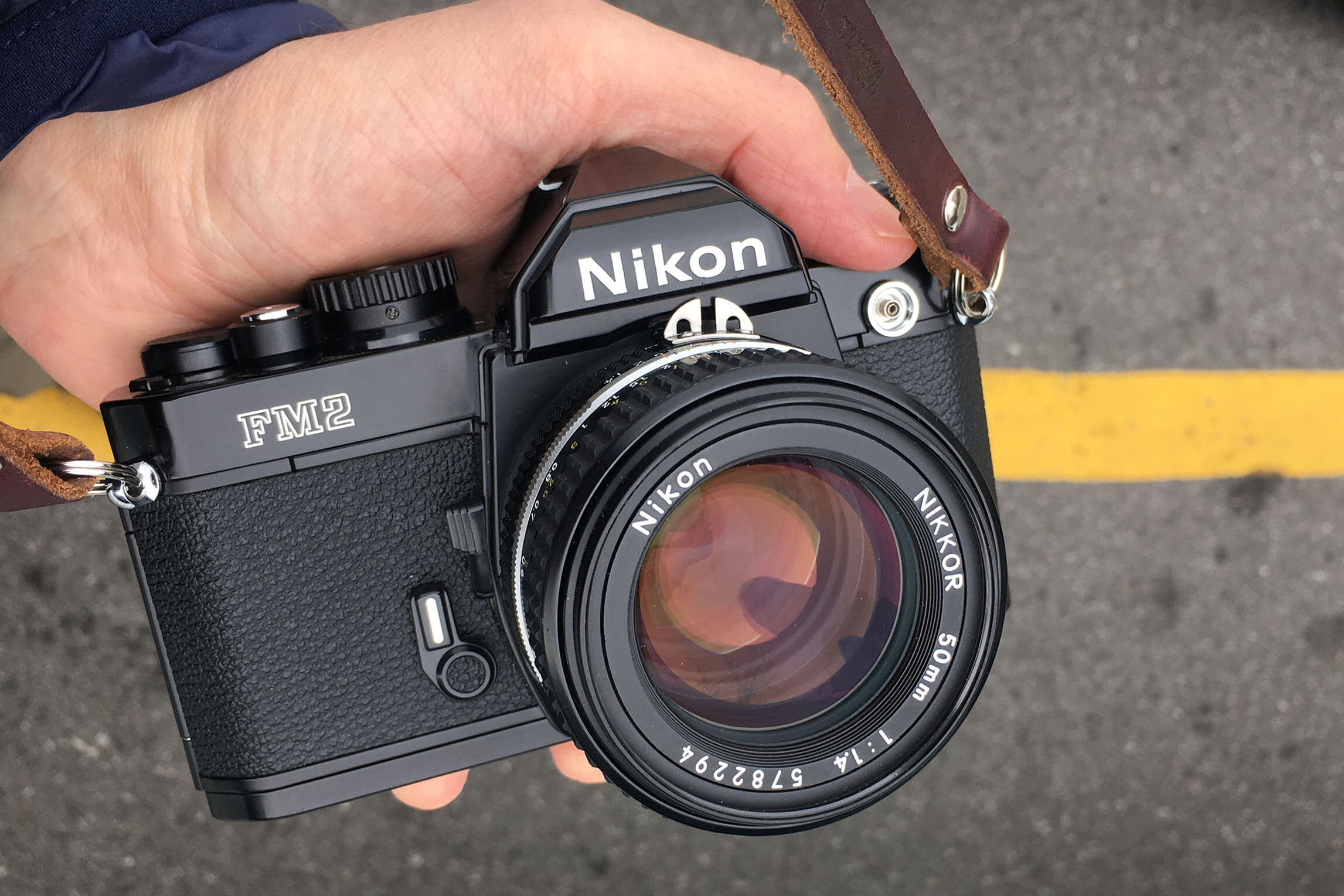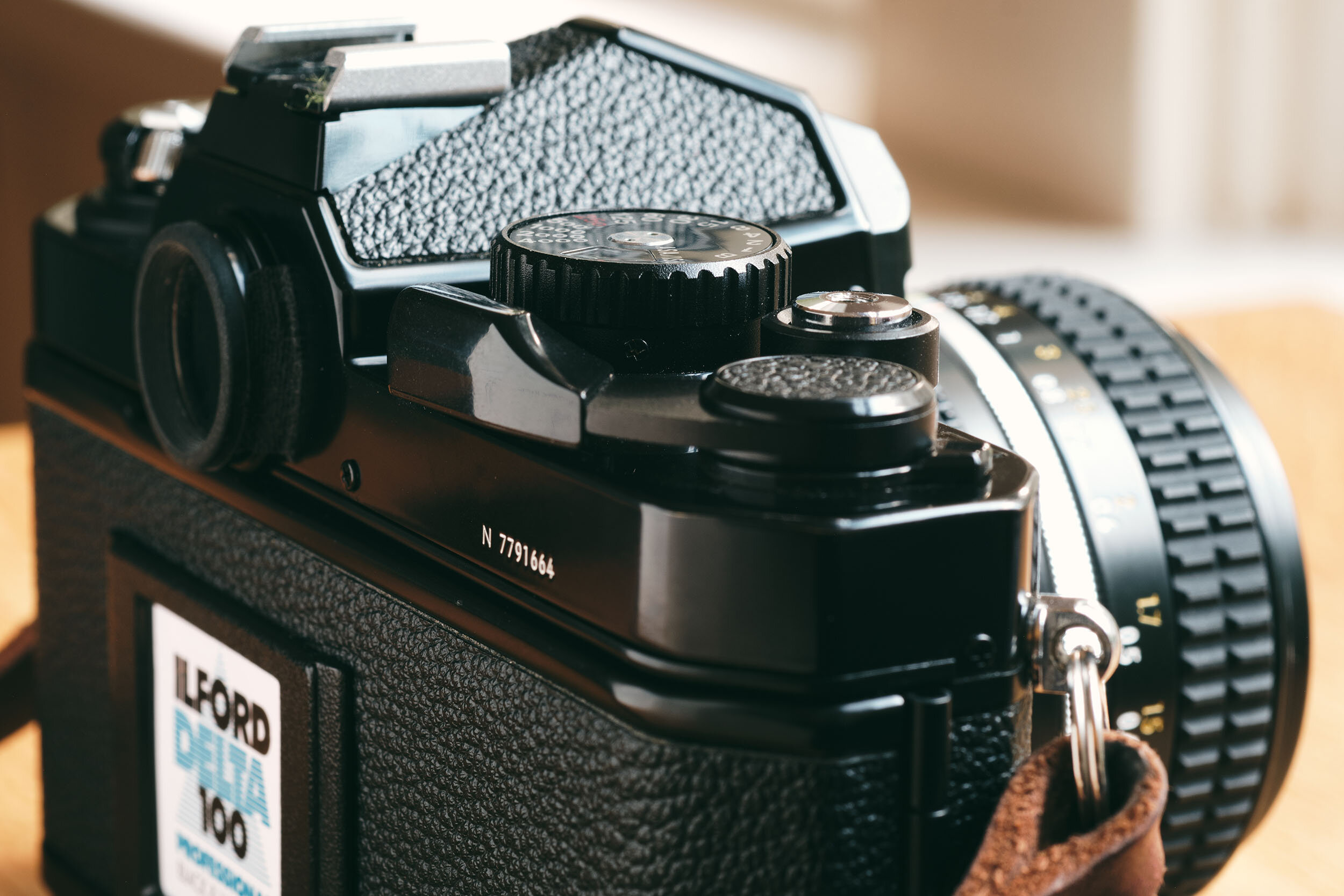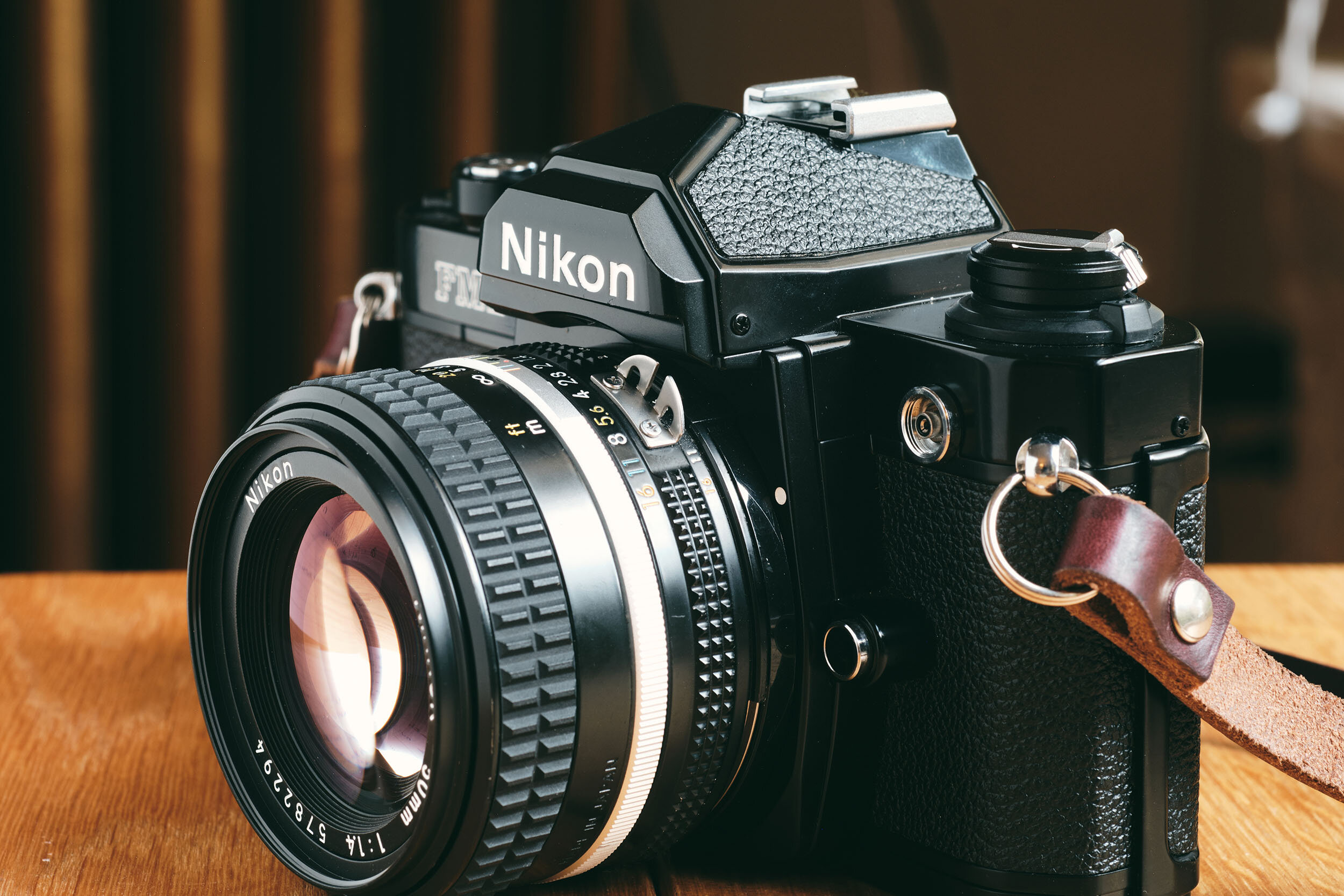Nikon FM2n Review

Nikon FM2n, black, shown with the Nikkor 50mm f/1.4 AIS
Nikon FM2n - A Desert Island Camera?
I have always been attracted to Nikon film cameras. They are rugged, and they have appealing classic design elements to boot. I have especially been attracted to the cameras from the FE and FM series from the late seventies and early eighties, as well as the iconic Nikon F3, which I had in the mid-eighties.
Perhaps this is no coincidence. These were the years that formed my photography journey, and looking at the older cameras today, nostalgia kicks in. It gives me great pleasure to research and use these cameras again after more than three decades.
The Nikon FM2n shown with a Nikkor 50mm f/1.4 AIS
Strangely enough, my affection for the older Nikon film cameras never rubbed off on my decision regarding cameras later on, when I found Canon to have better ergonomics. This trend started with the Canon T90, which I picked over the Nikon 8008, and later, when I picked a digital Canon D60 over the Nikon D100.
Buying a Nikon FM2n on eBay
I had scoured the local used market for a while, but rarely did I find any Nikon FM2n listings, and when I did, they looked to be in less-than-desirable shape. I turned to eBay and viewed several listings before finding a near-mint copy in Japan with a detailed description.
I paid $480.00, including shipping and taxes, which is very close to the original price in the mid-eighties. This was a bit more than I had planned to spend, but I have no concerns on this front. I am sure the FM2n will hold its value and probably even increase in value over time due to film photography gaining in popularity.
The Nikon FM2n shown with a Nikkor 50mm f/1.4 AI-S
Nikon FM2n - History
The Nikon FM2 was manufactured from 1982 to 2002. From 1984 onwards, the “n” for “new” was added to the official name along with the serial numbers on the back of the camera, although the front of the camera never changed and remained to show the FM2 logo.
The original Nikon FM2 has an X-Sync speed of 1/200s; for the Nikon FM2n, the X-Sync speed is 1/250s. Both cameras featured the first-ever shutter speed range of 1 to 1/4000th of a second and bulb, and did so without the need for batteries. Impressive, even to this day.
Lillooet, BC, Canada. Nikon FM2n, Nikon 50mm f/1.8 Series E, Kodak TMAX 100
Nikon FM2n Specs
The Nikon FM2n was categorized as an advanced semi-professional SLR camera known for its reputation, reliability, and durability.
The body, 19 oz (540 g), is constructed from copper-aluminum-silicon. The vertical metal shutter blades were fabricated of lightweight titanium in the original FM2, and in later FM2 models, shutter blades were made of aluminum.
You can use the FM2n without batteries, which is pretty cool, but for the light meter to work, you need two S76 or A76 batteries or one 1/3N battery.
The light meter is 60/40 center-weighted, and the only visible indication comes from three red LEDs showing either overexposure ‘+’ or underexposure ‘-’ or, in the middle, a circle indicating a suggested exposure.
The Nikon MD-12 motor drive shoots at 3.2 frames per second if you want an automatic film advance.
The Nikon FM2n shown with a Nikkor 50mm f/1.4 AI-S
First Impressions
I was quite astounded when I received the Nikon FM2n from Japan. It was mint as promised, and everything worked as it should. It is a great-looking camera, which helps lighten your mood when you take it out for a spin.
It has a hefty feel without being bulky or too heavy to carry around. The build quality is top-notch. I am having a hard time finding anything to be critical about, but of course, there is one thing.
To take photos with the Nikon FM2n, move the film advance lever from its flush position with the camera to unlock it.
As a left-eye shooter, it takes a bit of getting used to putting your eye up to the viewfinder, as the film advance lever sticks out. On the other hand, you can use the film advance lever as a thumb rest, giving you a steadier grip on the camera.
False Creek, Vancouver, Canada. Nikon FM2n, Nikon 50mm f/1.8 Series E, Kodak TMAX 100
Handling
I started using the Nikon 50mm f/1.8 Series E lens on the Nikon FM2n. This lens renders quite well, and I have enjoyed the photos from it, but it is on the small end of the scale for what I am comfortable with. I found a Nikkor 50mm f/1.4 AI-S locally, for $120.00, and I much prefer the size and feel of this lens.
The focus ring is wider, and changing the aperture is easier on the f/1.4 AI-S version. The f/1.4 lens adds an insignificant amount of weight, but overall gives a better camera/lens balance and grip.
Nikon FM2n in Action
You have to have a different mindset when shooting with the Nikon FM2n. Everything is fully manual, including exposure, focusing, and winding your film (unless you get the MD-12 motor drive). However, it can be a wonderful and tactile experience. You are in the driver’s seat, and it is all up to you.
I normally shoot in aperture priority mode and manually adjust via an exposure compensation dial. Shooting manually, I take the following approach with the Nikon FM2n.
First, I consider what ISO film I am using. Then, I dial my exposure in by picking an appropriate shutter speed for what I am shooting. For street photography, this is often 1/250 of a second.
Nikon Deals, Downtown Vancouver, Nikon FM2n, Nikkor 50mm f/1.4 AIS, Ilford Delta 100
Then I finally use the aperture ring to fine-tune my exposure depending on the scene. Remember, you do have a light meter to guide you along the way.
You must decide if you want over- or underexposure or perhaps use the combination of shutter speed and aperture suggested by the 60/40 center-weighted light meter.
It is a back-to-basics approach, and I do not mind. It reminds me of when you put a vinyl LP on your record player. First, you dust off the LP, then move the needle to the LP, and then you hear the crackling sound for a second or two before the music fills the room.
I will admit that once in a while, I miss the aperture priority mode that I had in my Nikon FE2, but then again, I tell myself it is healthy to slow down and think for a second.
Cambie Bridge, Vancouver, Nikon FM2n, Nikkor 50mm f/1.4 AIS, Ilford Delta 100
Nikon FM2n Conclusion
The term “desert island camera” is just a catchphrase and who wants to be stuck on an island running out of film, having no way to develop it, no access to Instagram, or any way of sharing your stunning island scenes with the world? :)
But let’s play the game for a second. Pretend you had an endless storage of film and a small lab next to your cozy hut where the fire always kept you warm.
With the Nikon FM2n, you could keep shooting without batteries till you either run out of food or a ship passes by to rescue you. As you can tell I have watched “Cast Away” too many times.
Burrard Bridge, Vancouver, Nikon FM2n, Nikkor 50mm f/1.4 AIS, Ilford Delta 100
The feeling of ruggedness in the Nikon FM2n, however, is very real and according to specs, you can operate it in extreme conditions from −40 °C to +50 °C. Personally, these specs are way overkill for what I would ever need and yet they are fun facts to keep in the back of your mind.
Nikon FM2n - Sample Images
Please see the sample images below. The negatives in this post were copied using a Fujifilm X-Pro2, an AF Micro Nikkor 60mm f/2.8D lens, and Skier Sunray Copybox 3. RAW files were imported to Lightroom and I used the Negative Lab Pro plugin to convert the files.
Please click to view larger images.
Burrard Bridge, Vancouver, Nikon FM2n, Nikkor 50mm f/1.4 AI-S, Ilford Delta 100
False Creek, Vancouver, Nikon FM2n, Nikkor 50mm f/1.4 AI-S, Ilford Delta 100
Cambie Bridge, Vancouver, Nikon FM2n, Nikkor 50mm f/1.4 AI-S, Ilford Delta 100
Pacific Central Station, Vancouver, Nikon FM2n, Nikkor 50mm f/1.4 AI-S, Ilford Delta 100
Waterfront Station, Vancouver, Nikon FM2n, Nikkor 50mm f/1.4 AI-S, Ilford Delta 100
Christ Church Cathedral, Vancouver, Nikon FM2n, Nikkor 50mm f/1.4 AI-S, Ilford Delta 100
False Creek, Vancouver, Nikon FM2n, Nikkor 50mm f/1.8 Series E, Kodak TMAX 100
Pemberton, BC, Nikon FM2n, Nikkor 50mm f/1.8 Series E, Kodak TMAX 100
Highway 99, BC, Nikon FM2n, Nikkor 50mm f/1.8 Series E, Kodak TMAX 100
Duffey Lake, BC, Nikon FM2n, Nikkor 50mm f/1.8 Series E, Kodak TMAX 100
Lillooet BC, Nikon FM2n, Nikkor 50mm f/1.8 Series E, Kodak TMAX 100
Stanley Park Seawall, Nikon FM2n, Nikkor 50mm f/1.8 Series E, Kodak TMAX 100
Spanish Banks, Vancouver, Nikon FM2n, Nikkor 50mm f/1.8 Series E, Kodak TMAX 100
Vancouver, Nikon FM2n, Nikkor 50mm f/1.4 AI-S, Kodak TMAX 100
Nikon SLR and F-Mount Lens Reviews
Nikon F3 HP
Nikon F3
Nikon F
Nikon FM3a
Nikon FM2n
Nikon FE2
Nikon EM
Voigtländer Ultron 40mm f/2 SL IIs
Voigtländer Nokton 55mm f/12. SL IIs
See all of my reviews at a glance: Camera Reviews - Archives




